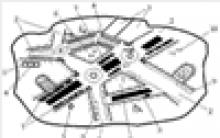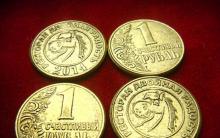Board game "Millionaire" is designed to familiarize children with commodity-money relations, improve counting skills and develop ingenuity. The task of the players is to buy objects that can bring dividends while moving around the playing field. The winner is the participant who turns out to be the richest by the end of the game. The game is represented by a colorfully executed playing field, chips, cards, tokens, play money and dice for determining the number of moves. The players alternately roll the dice and, making a certain number of moves, complete the task that falls to them. The task of each player is to make money and increase their capital. To increase capital, players can acquire various enterprises: banks, cinemas, supermarkets, which can bring them income. The winner is the participant who will be the richest millionaire at the finish line. The game promotes the training of counting skills, develops attention and ingenuity, teaches commodity-money relations. The product is certified and made from quality materials. In a set: cards, tokens, play money, playing field, chips, 2 dice, instructions. Number of prospective players: 2-6. Composition: cardboard, plastic. Recommended for children from 6 years old.
Actual color may differ from that shown on the website due to different monitor settings.
Origami NOR Classic Millionaire.
Is it easy to be a modern businessman? Uncover the colorful field of the Millionaire Classic game, and you will meet the exciting rules of fair and "shadow" business, tough laws of survival in the competitive struggle. Millionaire Classic is the tradition of Monopoly and Manager plus modernity. This is a game for millionaires of the third millennium.
Purpose of the game- become a monopolist and ruin the rest of the players.
The game can participate from 2 to 6 players. The playing field is a square. Movement across the field is carried out clockwise from the corner START cell. The sides are numbered from the first to the fourth also clockwise.
Along the perimeter of the playing field there are 8 colored BRANCHES, each of which consists of 3 sections with their own names. The square of each section of the playing field, indicating the cost of the land, the rent for the land and the price of construction, corresponds to a PLOT card with similar information.
Preparing to play.
AREA cards 24 pieces are laid out according to their branches on the corresponding sections of the playing field. Decks of cards CHANCE 20 pieces and MOVEMENT 20 pieces are placed on specially marked cells of the playing field, face down. Spare cards of 20 pieces are set aside. A banker is chosen among the players, who gives out 2OOO forfeits of initial capital to all the players, and also puts 200 forfeits in the Jackpot cashier. Players place their chips on the START square. The sequence of moves is determined by lot.
Game progress.
Each turn, players in turn roll two dice and move their tokens to the number of cells corresponding to the sum of the dropped points. If by the next move the player throws a double, two identical numbers on the dice, then he makes another move. If there are three takes in a row, the player is sent to the TAX INSPECTION.
If a player, as a result of the next move, stops on a plot that does not belong to any of the players, then he has the right to buy a plot in his possession. To do this, the player must pay to the BANK the amount indicated on the square of this area, after which he removes the card of this area from the field and keeps it for himself.
In case of refusal to purchase the site, the site is put up for auction. Any player, including the one who previously abandoned the purchase, can take part in the auction. The starting price of the exposed plot is arbitrary. The plot goes to the one who offers the highest price for it.
If, as a result of the next move, a player stops on a plot that is in someone else's possession, he must pay the owner of the plot the rent indicated on the corresponding square of the playing field. If a land plot is in monopoly ownership, that is, all plots of one industry belong to one owner, then the rent is doubled.
Each time a player passes the START cell on the next move, he is paid a circular income - 200 forfeits.
Surprise cells .
If a player's token enters the MOVE cell, its owner removes the top card from the MOVING deck and moves his token from the MOVING cell to the final cell indicated on the card. If there is a START box between these cells, then the circular income is not paid.
If, as indicated by the MOVEMENT, CHANCE cards, or as a result of the next move, the player enters the WHITE BUSINESS or CHARITY FUND cells, then he takes all the money that is there from the CHARITY FUND BANK.
If a player's token enters the CHANCE cell, its owner removes the top card from the CHANCE deck and follows the instructions indicated on it, after which he puts the card at the bottom of the deck. If the instruction cannot be carried out immediately, the player keeps the card with him until the right moment comes.
Once on one of the BLACK BUSINESS cells, the player must go to the CHARITY FUND cell and pay a fine of 50 forfeits to the CHARITY FUND BANK.
The player who hits the JACKPOT cell can play the slot machine. To do this, he makes a bet at the cashier's JACKPOT and rolls the die three times - once for each column of the slot machine - and then moves the chip from bottom to top along the column by as many symbols as the number of points on the die. In case of coincidence of the combination on the slot machine with the winning combination, the player receives the winning amount from the BANK. If the player loses, the bet remains at the box office. JACKPOT.
The player who gets to the TAX POLICE cell is sent to the TAX INSPECTION, while the circular income is not paid. Branches and enterprises. A player who monopolizes the entire industry can build branches and enterprises on the sites. Their price is indicated on the squares of the field and on the cards of the lots. The acquired branches and / or enterprises are placed by the player on the corresponding sections of the field.
In this case, the plots are built up sequentially: one branch at each, then a second branch, then a third. If three branches are built in all sectors of the industry, the player gets the right to build enterprises. The value of the enterprise is equal to the value of the branch. However, if there is at least one mortgaged site in the industry, the industry is considered incomplete, its owner ceases to be a monopolist, and the development of unencumbered sites in this industry is prohibited. If, experiencing financial difficulties, the player decides to sell his buildings to the BANK, he must remove them from plots evenly: one building from each plot. In this case, the BANK buys buildings from the player for half of their nominal price.
If a player needs money, he can mortgage a plot (or several), but before that he must sell all buildings from these plots to the BANK for half the price. After that, the BANK pays the owner half of the cost of the mortgaged site. At any moment of the game, but only before his turn, the player has the right to buy out the mortgaged area. To do this, he must return to the BANK half of the value of the mortgaged land plot plus 10% of its original cost.
There is no rental fee for players visiting the mortgaged area. The pledged plot can neither be sold nor exchanged until its owner is completely bankrupt.
Undeveloped plots can become the subject of sale and exchange between their owners. The terms of these transactions are governed by the property owners themselves on a mutual benefit basis. Players can enter into any deal and contractual relationship with each other. However, no land plot can be sold, mortgaged or exchanged if there is at least one building on it.
End of the game.
If the player owes the BANK or other players more than he is able to pay, he gives all the money he has, after which he is declared bankrupt and leaves the game. At the same time, the BANK pays the remaining part of the debt to its creditors. Branches and enterprises of bankruptcy are returned to the BANK.
PLOT cards are placed on the field on the corresponding squares.
The game continues until the complete bankruptcy of all players, except for one, who is declared the winner - the millionaire. You can also play against the clock, in which case the most wealthy participant at the time of the end of the game is considered the winner: plots, branches and enterprises are converted into money at the purchase price.
Included:
It's time to try on your monocle and top hat - you are on your way to becoming a millionaire! However, take your time, in the confused and cunning world of financial transactions, you can both fly to the very top and remain inconsolable bankrupt. In order not to be left without pants, you will need all your prudence, logic, foresight and, of course, luck. So, if you are ready to fight for the right to be the richest businessman within the confines of a single room and to undertake something profitable, then the season of hunting for a hard coin is declared open!
The rules of the Millionaire Classic game are as simple as the rules of the legendary Monopoly: buy plots of land, develop your business in various industries and try your luck as you move around the playing field. Ruthlessly shake the money from the gaping competitors who have come to your site, avoid dark ties with the "black" business, hope for the lucky "Chance" card and do not pass by slot machines - gambling can bring you extra easy money! The goal of the game is the goal of the life of any calculating monopolist - to leave all competitors with a nose and remain the sole owner of factories, newspapers, ships on the field.
If you feel entrepreneurial, if you are not intimidated by treacherous competitors, the tax police and possible bankruptcy, and if your love of finance is as great as your love of board games, then you will definitely appreciate the Classic Millionaire.
Recently, many variants of the Millionaire board game have appeared on the market. This is an economic game that gathers the whole family or a group of friends behind the playing field. The rules are not too complicated. People who love "Monopoly" will be happy to get to know "Millionaire".
In this article we will consider the rules of the Millionaire (Classic) board game. This is one of the fundamental game modifications. The rest of the options have been expanded, with several new rules added. We will understand them in more detail later.
Game package
When buying a box with the Millionaire board game, you need to check the package contents. This is a square-shaped playing field folded in four. Two that help to decide how many cells the player's piece moves. Since this game can be played by either two or six players, the chips are given 6 pieces, respectively, to the maximum.
In a special department, "money" is kept separately for doing business. Banknotes of different denominations (1, 5, 10, 20, 50, 100, 500), each pack contains 48 pieces. The money in the game is called "phantom". The set also includes cards of branches (24 pcs.) And enterprises (12 pcs.). There are also prize cards called "Chance" and "Move". There are 20 of them in a set. There are also designations of areas, of which there are 24.
There are also printed rules in the box.
Purpose of the game
Since the board game "Millionaire" is an economic game, its main goal is to earn as much money as possible, to buy up most of the enterprises in all sectors of the economy. Also, the player can conclude lucrative real estate transactions, expanding businesses and rebuilding branches.
The winner is the player who becomes a monopolist and fully owns all the enterprises in the industry. To become a winner, you need not only to be lucky, but also to have the "vein" of a businessman and have the ability to predict situations and moves of opponents.
Classic game rules
The playing field has 8 sectors that symbolize different industries: the transport system, the media, light and food industries, mining and heavy, communications and communications, and the entertainment industry. These 8 sectors are located around the perimeter of the playing field. Plot cards are laid out on the squares with enterprises. In the center of each strip of the Millionaire board game are the most expensive businesses.

And in the middle of the playing field there is a slot machine called "Jackpot" and "Charitable Foundation Bank". The purpose of these cells will be discussed later. Cards with corresponding names are placed on the "Chance" and "Movement" cells, which are located one, two or three cells along the perimeter of the playing field. They are placed with the "shirt" up, so that the player does not see the upcoming task in advance.
Beginning of the game
During the draw, the player who makes the first move is selected. In the board game "Millionaire", the cells are counted clockwise from the word "Start". Before starting any game, you need to appoint a banker of the most popular player. He must distribute the initial capital - 2000 forfeits in bills of different denominations. When the player rolls the dice, the points are calculated, the token is moved by the corresponding number of cells. If you are "lucky" and have a double, you will have to roll the dice again. But if the double drops out three times in a row, then the player is forced to go to the box with the inscription "Tax Police". Such a move is fraught with the payment of penalties.

According to the rules of the board game "Millionaire" Classic, if a chip hits the cell of an enterprise, then the player takes a plot card for himself, on which it is written in detail how much taxes must be paid for the enterprise itself or the rental rate for it. If this enterprise does not yet have an owner, then the player can buy it, deposit the required value for it in the Bank. The site card remains with the player in the pack.
If a player is not interested in buying a given plot, he puts it up for sale, having independently determined its value. The site goes to the player who offers a large amount at the auction.
If, as a result of the roll of the dice, a chip of another player finds itself on your site, then for being in someone else's enterprise you will have to pay as many forfeits as indicated on the card. There are situations when a chip falls on a cell belonging to a monopolist, that is, a player who has bought up all enterprises in a given industry, then the rate is doubled, the rent is already paid at a double rate.
There are also pleasant moments. When a player makes a full circle around the playing field, then according to the rules of the Millionaire board game, he receives a bonus of circular income of 200 forfeits.
"Surprise" cells
In the course of throwing in the dice, the players' pieces can also fall on the squares with the "backs" turned up. These are "Chance" and "Movement". Let's take a closer look at what you need to do in such cases:
- Turning over the card on the cell, the player reads the task and must complete it. If at this moment he is not able to fulfill the given, then this can be done later.
- When hitting the "Move", as can be seen from the name of the card, the player will need to move the chip to the distance indicated on it. If the chip suddenly hits the "Start", then the player loses the circular income, that is, 200 forfeits. If, when performing a move, a chip falls on the "White Business" or "Charitable Fund" cell, then the player receives a cash prize from the funds of the Bank or the Fund. But there is also a cell with the inscription "Black Business". Having got on it as a result of moving the chip, the player is automatically moved to the square of the "Charity Fund", where he already has to contribute 50 forfeits to charity.
- Jackpot. A slot machine is located in the center of the playing field, so that when a chip hits it, the player can play. In the Millionaire board game, according to the rules of the game, you first need to place a bet. Then only one die is rolled, the throw is made three times. After each throw, the player must rearrange the chip up the column by the corresponding number of cells. If the pictures match the winning combination, the winner receives a bonus prize. But if the player is unlucky, the combination did not match, then the bet remains in the cashier of the Bank.

Corner cages
On the corner squares of the playing field there are "Tax Police" and "Tax Office". If the chip gets to the inspection after the move, then the tax is simply paid. If the chip finds itself on the police cage, then you need to throw the dice 3 times (until a double falls out) in order to leave the territory of the site. If the double did not fall, then you will have to fork out and pay a fine.
Board game "Monopoly: Millionaire"
This is a new economic game, beautifully and stylishly designed. Children from 8 years old will be able to play it. Players can be from 2 to 4 people. The main goal of the game is to become a millionaire, that is, to make a million. Whoever conquers this peak first is the winner. Each player has three chips on hand.
The game begins with the "Forward" cell, on which one chip is placed. The others are still standing to one side on the table. The banker is not used in the game. There is a cell on the playing field where all the players' money is kept. At first, the games are handed out to everyone in 372 thousand bills. It is no longer necessary to buy here enterprises or houses, but elite property - this is an island, a city of attractions, a castle, etc. They choose a realtor who issues cards with real estate.

If a piece makes a full circle around the playing field, then the player changes it to a larger one. This marks the next level of security - "Living in luxury". And the higher the level, the greater the player's income. But for such a transition, you will have to pay 50 bills.
In this game there are already familiar to the players "Chance" cards, but there are also new ones, for example, "Life of a Millionaire" and "Fortune". They contain very interesting offers: getting a wedding gift from other players or money from the sale of a sports car, etc.
There is also a new cell "Prison". If you just hit it with a chip, no action can be taken until the next move. The player who is "lucky" to throw a double in a row with dice three times in a row gets there. You will either have to sit in dungeons for three moves, or give the corresponding card.
The rest of the rules of the game are similar to the classic "Millionaire". You can also buy, rent, sell your property. Only instead of branches, there are monochrome objects.
Business game
Millionaire is a board game that already has many variations. Now let's look at another one released by a Russian company. The game is designed for children from 7 years old. She teaches them about business in a fun way. The goal is the same as in all other options - to get rich by buying real estate, selling services and goods. 17 types of activities and industries are represented.

The playing field is decorated differently, cells for moves are represented by circles. The bank is located in the middle, where, depending on the player's earnings, the chips move up the steps, closer to the coveted million. The game is simple, you can play with the whole family - parents with children.
Child Game
In the last place, we will describe even children will master. The main goal of the game is to get rich buying up banks, shops, cinemas, etc.

The guys throw dice, make moves with chips and do the tasks written on the cards. The winner is the one who became the richest man before everyone else.
So, the article describes the popular games "Millionaire", the rules of the game, options for adults and children. All of them teach prudence, the ability to foresee the situation, attentiveness and logical thinking. These business games are useful for developing an entrepreneurial spirit in children, which will come in handy in adulthood.
The rules of the classic Millionaire board game? write if anyone knows, otherwise we can't figure it out in any way and got a better answer
Answer from WannaBe [guru]
The game can participate from 2 to 6 players. Movement across the field is carried out from the corner cell "Start" clockwise. Along the perimeter of the playing field there are 8 colored "Branches", each of which consists of 3 sections with their own names. The square of each section of the playing field, indicating the cost of the land, the rent for the land and the price of construction, corresponds to a Land card with similar information.
Plot cards are laid out according to their branches on the corresponding sections of the playing field. Decks of Chance and Movement cards are placed on the specially designated cells of the playing field "face down". A banker is chosen from among the players, who gives out 2,000 forfeits of initial capital to all players, and also puts 200 forfeits in the “Jackpot” cashier. Players place their chips on the Start space.
Each turn, players in turn roll two dice and move their tokens to the number of cells corresponding to the sum of the dropped points. If on the next move the player throws a double (two identical numbers on the dice), then he makes another move.
If a player, as a result of the next move, stops on a plot that does not belong to any of the players, then he has the right to buy a plot in his possession. To do this, the player must pay to the Bank the amount indicated on the square of this area, after which he removes the card of this area from the field and keeps it for himself. In case of refusal to purchase the site, the site is put up for auction. Any player can take part in the auction. The starting price of the exposed plot is arbitrary. The plot goes to the one who offers the highest price for it.
If, as a result of the next move, a player stops on a plot that is in someone else's possession, he must pay the owner of the plot the rent indicated on the corresponding square of the playing field. If a land plot is in monopoly ownership, that is, all plots of one industry belong to one owner, then the rent is doubled.
Each time a player passes the Start cell on the next move, he is paid a circular income - 200 forfeits.
If a player's token enters the "Move" or "Chance" square, its owner removes the top card from the corresponding deck and follows the instructions.
Once on other "surprise cells" - "Charitable Foundation", "Tax Inspectorate, etc., the player must follow the appropriate instructions of the rules of the game - take money, pay a fine, etc.
A player who monopolizes the entire industry can build branches and enterprises on the sites. Their price is indicated on the squares of the field and on the cards of the lots. The acquired branches and / or enterprises are placed by the player on the corresponding sections of the field. In this case, the plots are built up sequentially: one branch at each, then a second branch, then a third. If three branches are built in all sectors of the industry, the player gets the right to build enterprises. The value of the enterprise is equal to the value of the branch. However, if there is at least one mortgaged site in the industry, the industry is considered incomplete, its owner ceases to be a monopolist, and the development of unencumbered sites in this industry is prohibited.
If a player needs money, he can sell his buildings to the Bank or mortgage a plot (or several). At any moment of the game, but only before his turn, the player has the right to buy out the mortgaged area. There is no rental fee for players visiting the mortgaged area. The pledged plot can neither be sold nor exchanged until its owner is completely bankrupt.
Undeveloped plots can become the subject of sale and exchange between their owners. The terms of these transactions are governed by the property owners themselves on a mutual benefit basis. Players can enter into any deal and contractual relationship with each other. However, no land plot can be sold, mortgaged or exchanged if there is at least one building on it.











Get carried away with the game. The meaning of the word get carried away. Teamwork and the ability to communicate in a team
The intellectual and faith: how to come to God, and not get carried away with the "glass bead game
These children's puzzles are not suitable for every adult.
Fanny Family Games Teavee is the best video blogger of the Roblox
Ideas and suggestions The future of the project and fashion for the game Eve Online